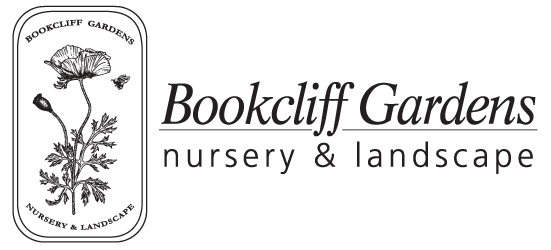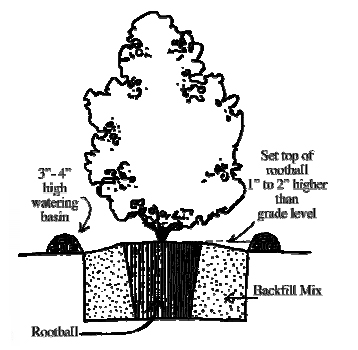GARDEN CENTER & NURSERY
LANDSCAPING SERVICES
MAINTENANCE
HOURS
Vines Planting Instructions
Location and SelectionNot all vines are alike. Think about what you would like the vine to do before you grab the first pretty pot! Would you like the vine to sprawl on the ground as a ground cover or climb a wall or trellis? Would you rather have something that stays evergreen in the winter or can it lose it’s leaves? Will the vine be growing in the sun or shade? Would you like your vine to produce ornamental flowers or berries? Do you want to attract Hummingbirds? Take all these things into consideration before choosing your vine. Make sure that your vine is appropriate for your location.Planting Dig a hole twice as wide and only as deep as the root ball of the vine. Be sure to adjust the hole so that the top of the root ball is 1" to 2" above ground level. Next, remove the container. Plastic pots can be removed by turning the plant upside down or laying it on its side and gently tapping at the pot until it slides out. Refill the hole with a blended mixture of 1/3 Soil Pep and 2/3 of your garden soil. Firm the backfill by tamping it gently. Build a watering basin around the plant high enough to hold 3" to 4" of water. Make the basin at least as wide as the hole that was dug. Immediately water the plant deeply by filling the basin with water once, letting it soak in, and filling it up a second time. The use of Fertilome Root Stimulator at planting time will greatly reduce transplant shock and encourage your vines to resume their normal growing habits more quickly.FeedingNext spring, fertilize with Bookcliff Gardens Choice Professional Turf Food. Scatter evenly beneath the plant in late April and then again in mid June. Be sure to water it in well after applying. This will give your vine a slow, even feeding throughout the growing season.Vine CategoriesVines fall into four general climbing categories:1) Twining: New growth on these vines twist and spiral as they grow. They twist around themselves and other plants nearby. These vines require some guidance and a structure to grow on. Vines that fall into this category are: Honeysuckle, Wisteria, Bittersweet, Clematis, and Silverlace.2) Tendrils: These vines have specialized growths that reach out and grab onto the nearest thing they can make contact with. Engleman Ivy and Grapes fall into this category.3) Clinging: These vines can climb up a wall without a trellis or support. They have “Sucker Discs” that hook into small irregularities and crevices on flat surfaces. Vines in this category might be: Wintercreeper, Trumpet Vine, Boston Ivy and English Ivy.4) Must Be Tied: Some vines have no means of support and they need to be tied to a trellis. A familiar vine that falls into this category would be Climbing Roses.
Training and PruningMost vines are just pruned to keep them within bounds, but you can “renovate” your old vine occasionally. Do this by thinning out dead, old, or winter damaged growth to encourage fresh new, lush vines. Most Clematis varieties that are grown here are best maintained by cutting the entire plant back to 12” early each spring.Plants such as Wisteria, Trumpet Vine and Grapescan be pruned into a permanent, woody framework. To do this, form a multi or single trunk up to the height desired and horizontal branches or “arms” to cover the area. The vine can be maintained to the basic size of your framework by pruning back to two bud “spurs” early each spring.WateringIt is impossible to give a watering schedule that will be right for everyone all of the time. Factors such as the soil type, how big the plant is, how fast the plant is growing, air temperature, humidity, wind and light intensity all will affect how often a particular plant will need watering.The basic rule of thumb is to water deeply, but infrequently. Get the water down a minimum of 18" at each watering. This encourages the plant to develop a deep, drought tolerant root system. Then give the soil a chance to dry slightly between waterings. It is common for people to kill or unnecessarily stress their plants by watering too frequently. The roots of a plant require oxygen in order to function. If the soil is constantly waterlogged, there is not enough oxygen available to the root system and the roots suffocate and begin to die.Knowing this, our recommendation is to water deeply by building a basin around plants that are not watered by lawn sprinklers. It should be wide enough to accommodate the root system of the plant (generally out to the drip line of the plant) and high enough to hold three or four inches of water when full. Fill the basin full, let it soak in, and fill it a second time. Then don't water the plant again until the soil in the basin begins to dry. Don't just look at the soil surface; dig down 4" to 6" to see how dry the soil is. The soil should be showing some significant drying down at that depth. One little trick is to scoop up a handful of soil from that depth and squeeze it into a ball. If the ball holds its shape after you let go, the soil is still wet. If the ball falls apart, it’s time to water. Using this method several times, you will be able to determine your own watering schedule.For plants that will be watered with lawn sprinklers, water as described above at planting time. Then remove the basin. Most of the plant's day to day water needs will be met by the lawn watering. However, a deep soaking every month or two is recommended in addition to the lawn watering. In addition, during the winter a monthly deep soaking of all newly planted shrubs is a good idea. This should be done for the first two winters after planting.
Download PDF Instructions
Questions?
Call 242-7766
Our GuaranteeThanks for buying a plant from Bookcliff Gardens. Our goal is that you be successful with every plant you purchase from us. We'll try to give you as much information and instruction as it takes to make this happen. If you have any questions, please ask! We'll do our best to answer them. However, since this is not a perfect world, and in spite of the best of both of our efforts, plants sometimes die. If this happens within the first year after buying the plant from us, we will replace it; give you an equal amount of credit; or refund the purchase price. You must have your receipt for the guarantee to be honored. We limit our guarantee to replacing a plant only once, and the guarantee does not apply to annual bedding plants, perennials or house plants. If you're having a problem with a plant, come in and talk to us about it; we'll try to find out what happened so we won't lose another plant. It's in both of our interests that the plants you buy from us grow and thrive. We want you to be successful!


